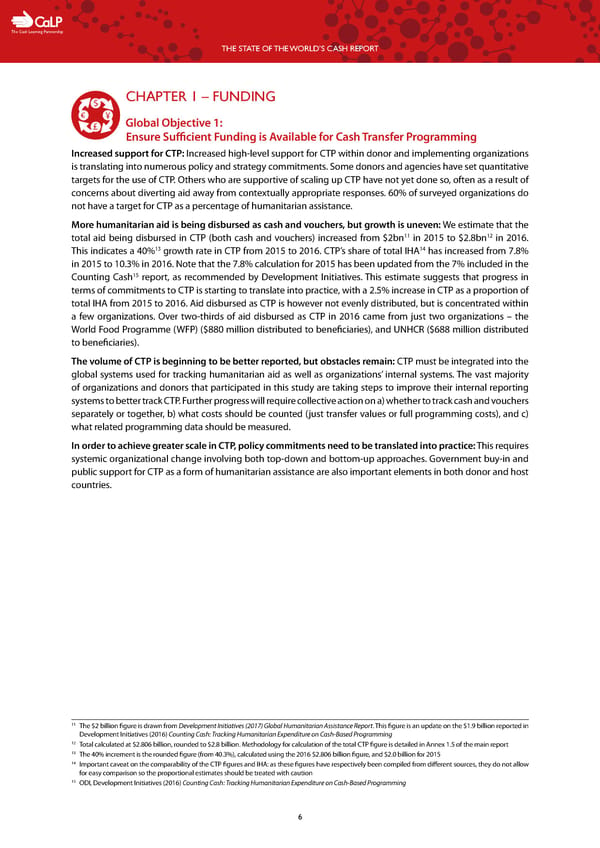C The Cash Learning Partnership THE STATE OF THE WORLD’S CASH REPORT CHAPTER 1 – FUNDING Global Objective 1: Ensure Sufficient Funding is Available for Cash Transfer Programming Increased support for CTP: Increased high-level support for CTP within donor and implementing organizations is translating into numerous policy and strategy commitments. Some donors and agencies have set quantitative targets for the use of CTP. Others who are supportive of scaling up CTP have not yet done so, often as a result of concerns about diverting aid away from contextually appropriate responses. 60% of surveyed organizations do not have a target for CTP as a percentage of humanitarian assistance. More humanitarian aid is being disbursed as cash and vouchers, but growth is uneven: We estimate that the 11 12 total aid being disbursed in CTP (both cash and vouchers) increased from $2bn in 2015 to $2.8bn in 2016. 13 14 This indicates a 40% growth rate in CTP from 2015 to 2016. CTP’s share of total IHA has increased from 7.8% in 2015 to 10.3% in 2016. Note that the 7.8% calculation for 2015 has been updated from the 7% included in the 15 Counting Cash report, as recommended by Development Initiatives. This estimate suggests that progress in terms of commitments to CTP is starting to translate into practice, with a 2.5% increase in CTP as a proportion of total IHA from 2015 to 2016. Aid disbursed as CTP is however not evenly distributed, but is concentrated within a few organizations. Over two-thirds of aid disbursed as CTP in 2016 came from just two organizations – the World Food Programme (WFP) ($880 million distributed to beneficiaries), and UNHCR ($688 million distributed to beneficiaries). The volume of CTP is beginning to be better reported, but obstacles remain: CTP must be integrated into the global systems used for tracking humanitarian aid as well as organizations’ internal systems. The vast majority of organizations and donors that participated in this study are taking steps to improve their internal reporting systems to better track CTP. Further progress will require collective action on a) whether to track cash and vouchers separately or together, b) what costs should be counted (just transfer values or full programming costs), and c) what related programming data should be measured. In order to achieve greater scale in CTP, policy commitments need to be translated into practice: This requires systemic organizational change involving both top-down and bottom-up approaches. Government buy-in and public support for CTP as a form of humanitarian assistance are also important elements in both donor and host countries. 11 The $2 billion figure is drawn from Development Initiatives (2017) Global Humanitarian Assistance Report. This figure is an update on the $1.9 billion reported in Development Initiatives (2016) Counting Cash: Tracking Humanitarian Expenditure on Cash-Based Programming 12 Total calculated at $2.806 billion, rounded to $2.8 billion. Methodology for calculation of the total CTP figure is detailed in Annex 1.5 of the main report 13 The 40% increment is the rounded figure (from 40.3%), calculated using the 2016 $2.806 billion figure, and $2.0 billion for 2015 14 Important caveat on the comparability of the CTP figures and IHA: as these figures have respectively been compiled from different sources, they do not allow for easy comparison so the proportional estimates should be treated with caution 15 ODI, Development Initiatives (2016) Counting Cash: Tracking Humanitarian Expenditure on Cash-Based Programming 6
 The State of the World's Cash | Full Report Page 7 Page 9
The State of the World's Cash | Full Report Page 7 Page 9